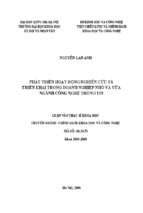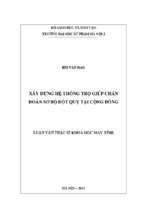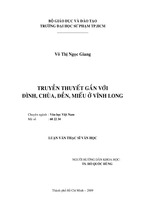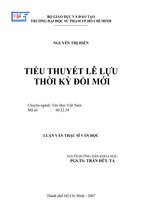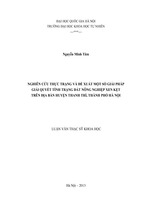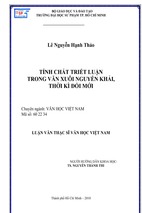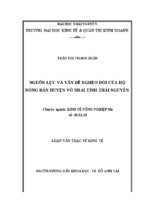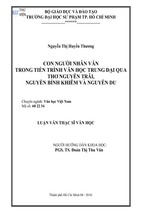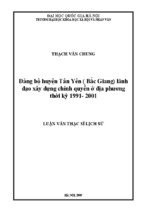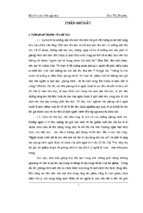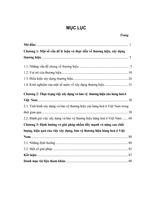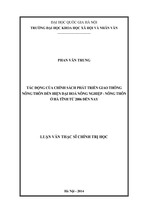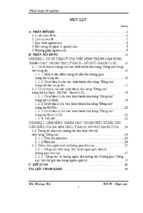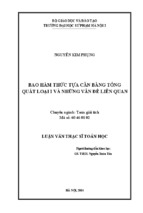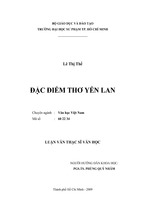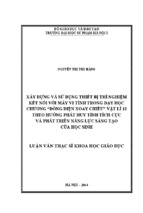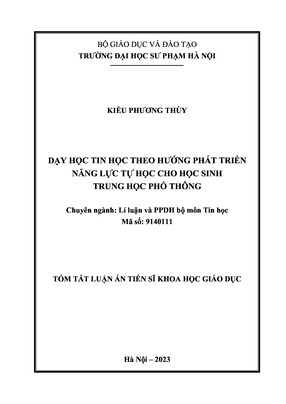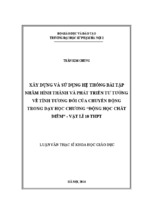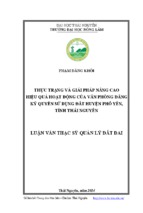VIETNAM NATIONAL UNIVERSITY – HOCHIMINH CITY
UNIVERSITY OF SOCIAL SCIENCES & HUMANITIES
FACULTY OF ENGLISH LINCUISTICS & LITERATURE
AN INVESTIGATION INTO EFL STUDENTS’
PERCEPTIONS OF INTERACTIVE
WEB-BASED LEARNING TOOLS AT SAIGON
TOURIST HOSPITALITY COLLEGE
A thesis submitted to the
Faculty of English Linguistics & Literature
in partial fulfillment of the Master’s degree in TESOL
By
BUI THI KIM LOAN
Supervised by
NGUYEN THU HUONG, Ph.D.
HO CHI MINH CITY, MAY 2018
i
ACKNOWLEDGEMENTS
First and foremost, I would like to express my sincere gratitude to my thesis
supervisor, Dr. Nguyen Thu Huong, for his wholehearted support to my thesis. His
dedicated guidance and encouragement have always impressed me since I was in his
Advanced Teaching Methodology class. Without his tremendous enthusiasm,
comments and professional expertise, I would not have completed the thesis. He
counseled, corrected and accompanied me from the beginning to its completion.
I would also like to extend my grateful thanks to others who have helped me are:
authorities, teachers, and students at Saigon Tourist Hospitality College for their
support during the time I conducted the study and completed the thesis.
Last but not least, I would like to extend my heartfelt gratitude to my parents,
especially my husband, my daughter for their understanding, whole-hearted
encouragement and continuous support during my thesis writing. Without them, the
thesis would not have been completed.
ii
STATEMENT OF ORIGINALITY
I certify that this thesis, entitled “An investigation into EFL students’ perceptions
of interactive web-based learning tools at Saigon Tourist Hospitality College” is
my own work.
This thesis has not been submitted for the award of any degree or diploma in any
other institution.
Ho Chi Minh City, November 2017
Bui Thi Kim Loan
iii
RETENTION AND USE OF THE THESIS
I hereby state that I, Bui Thi Kim Loan, being the candidate for the degree of Master
of Arts in TESOL, accept the requirements of the University relating to the retention
and use of Master’s thesis deposited in the Library.
In terms of these conditions, I agree that the original of my thesis deposited in the
Library should be accessible for the purposes of study and research, in accordance
with the normal conditions established by the Library for the care, loan and
reproduction of thesis.
Ho Chi Minh City, November 2017
Bui Thi Kim Loan
iv
TABLE OF CONTENTS
ACKNOWLEDGEMENTS ............................................................................................ i
STATEMENT OF ORIGINALITY ............................................................................... ii
RETENTION AND USE OF THE THESIS ................................................................ iii
TABLE OF CONTENTS .............................................................................................. iv
LIST OF TABLES ....................................................................................................... vii
LIST OF FIGURES ...................................................................................................... ix
ABSTRACT ................................................................................................................... x
CHAPTER 1 INTRODUCTION .................................................................................. 1
1.1
Background of the study ................................................................................... 1
1.2
Aims of the study.............................................................................................. 5
1.3
Research questions ........................................................................................... 5
1.4
Hypothesis ........................................................................................................ 5
1.5
Significance of the study .................................................................................. 6
1.6
The scope of the study ...................................................................................... 6
1.7
Limitation of the study ..................................................................................... 6
1.8
Organization of the thesis ................................................................................. 7
CHAPTER 2 LITERATURE REVIEW ........................................................................ 8
2.1
Definition of terms ........................................................................................... 8
2.1.1
Web-based learning tools .......................................................................... 8
2.1.2
E-learning .................................................................................................. 9
2.1.3
Computer- Assisted Language Learning (CALL) ..................................... 9
2.2
Computer-Assisted Language Learning ........................................................... 9
2.2.1 Three phases of CALL ...................................................................................... 9
2.2.2 Major theoretical approaches to CALL ........................................................... 11
2.3
Usefulness of web-based learning environment ............................................. 13
2.4
Review of previous studies ............................................................................. 15
2.4.1
Previous studies on perceptions of interactive Web-based learning ....... 15
v
2.4.2 Previous studies on perceptions of interactive Web-based learning in
Vietnam ................................................................................................................. 23
2.5
Conceptual framework of the study ............................................................... 26
CHAPTER 3 METHODOLOGY ................................................................................ 28
3.1
Research design .............................................................................................. 28
3.2
Research site ................................................................................................... 29
3.3
The participants .............................................................................................. 29
3.4
Research instruments ...................................................................................... 30
3.4.1. Questionnaire .................................................................................................. 30
3.4.2 Interview .......................................................................................................... 32
3.5
Data collection procedure ............................................................................... 33
3.5.1
Distributing the questionnaires ................................................................... 33
3.5.2
Conducting the interviews .......................................................................... 33
3.6
Procedures of data analysis ............................................................................ 34
3.6.1
Analyzing data from the questionnaire ....................................................... 34
3.6.2
Analyzing data from the interview.............................................................. 35
3.6.3
Summary of the chapter .............................................................................. 35
CHAPTER 4 RESULTS AND DISCUSSION ............................................................ 36
4.1
4.1.1
Analysis of data .............................................................................................. 36
Reliability Statistics .................................................................................... 36
4.1.2 Students’ perceptions of interactive web-based learning in regard with
engagement-based purposes ..................................................................................... 39
4.1.3 Students’ perceptions of interactive web-based learning in regard with
usability..................................................................................................................... 41
4.1.4
Students’ perceptions of challenges in interactive web-based learning ..... 46
4.1.5
Participants’ opinions in the interview........................................................ 51
4.2
Discussion of results ....................................................................................... 52
4.2.1
Engagement-based purposes of students in interactive web-based learning
52
4.2.2
Usability of using interactive web-based learning tools ............................. 54
vi
4.2.3
Challenges in interactive web-based learning ............................................. 54
4.2.4
Students’ experience of interactive web-based learning tools .................... 55
4.3
Summary......................................................................................................... 55
CHAPTER 5 CONCLUSION ...................................................................................... 56
5.1
Conclusion ...................................................................................................... 56
5.2
Implications of the study ............................................................................... 57
5.3
Limitations of the study .................................................................................. 59
5.4
Recommendation for further study................................................................ 59
REFERENCES............................................................................................................. 61
APPENDICES ............................................................................................................. 69
APPENDIX A- VIETNAMESE QUESTIONNAIRE ............................................. 70
APPENDIX B- ENGLISH QUESTIONNAIRE ...................................................... 74
APPENDIX C – INTERVIEW QUESTIONS ......................................................... 77
APPENDIX D- THE USE OF WEB-BASED LEARNING AT SAIGON TOURIST
HOSPITALITY COLLEGE ..................................................................................... 78
APPENDIX E- FULL DESCRIPTIVE STATISTICS OF ENGAGEMENT-BASED
PURPOSES............................................................................................................... 79
APPENDIX F- FULL DESCRIPTIVE STATISTICS OF USABILITY OF
INTERACTIVE WEB-BASED LEARNING TOOLS ............................................ 81
APPENDIX G- FULL DESCRIPTIVE STATISTICS OF CHALLENGES IN
INTERACTIVE WEB-BASED LEARNING TOOLS ............................................ 83
APPENDIX I- FULL PERCENTAGE OF INTERACTIVE WEB-BASED
LEARNING TOOLS THAT STUDENTS USED SO FAR .................................... 85
vii
LIST OF TABLES
Table 2.1. Warschauer’s three stages of CALL ............................................................. 9
Table 2.2. The role of call in structural, cognitive, and socio-cognitive frameworks . 13
Table 3.1. Specific time of collecting data .................................................................. 34
Table 3.2. Coding scheme for the Likert scales ........................................................... 34
Table 4.1. Reliability of engagement-based purpose questionnaire ............................ 36
Table 4.2. Reliability of usability of interactive web-based learning questionnaire ... 37
Table 4.3. Reliability of challenges of interactive web-based learning questionnaire 37
Table 4.4. Reliability of scale used in the study .......................................................... 38
Table 4.5. Descriptive statistic of engagement-based purposes .................................. 39
Table 4.6. Descriptive statistic of using interactive web-based learning tools to gain
knowledge related to the field ...................................................................................... 40
Table 4.7. Percentage of students’ computer possession ............................................. 41
Table 4.8. Descriptive statistic of usability of interactive web-based learning tools .. 42
Table 4.9. Students’ perception of the usefulness of interactive web-based learning
tools .............................................................................................................................. 43
Table 4.10. Students’ perception of improving communication between students and
teachers ......................................................................................................................... 43
Table 4.11: Description of One-Sample T-test ............................................................ 44
Table 4.12. Descriptive statistic of usability, engagement-based purposes and
challenges of using interactive web-based learning tools ............................................ 45
Table 4.13. Description of comparing positive attitude and challenges in using
interactive web-based learning tools ............................................................................ 45
Table 4.14. Descriptive statistic of challenges in interactive web-based learning tools
...................................................................................................................................... 47
viii
Table 4.15. Percentage of slow internet connectivity problem in using Interactive
web-based learning tools .............................................................................................. 48
Table 4.16. Description of social isolation when using Interactive web-based learning
tools .............................................................................................................................. 48
Table 4.17. Percentage of interactive web-based learning tools that students used so
far ................................................................................................................................. 49
Table 4.18. Descriptive statistic of using Facebook as Interactive web-based learning
tools .............................................................................................................................. 50
Table 4.19. Descriptive statistic of using You tube as Interactive web-based learning
tools .............................................................................................................................. 50
Table 4.20. Descriptive statistic of using other tools as Interactive web-based learning
tools .............................................................................................................................. 50
ix
LIST OF FIGURES
Figure 2.1. Usefulness of web-based learning environment is a combination of its
usability and utility. Utility can be divided into two categories: pedagogical usability
and added value of web-based learning and teaching .................................................. 14
Figure 2.2. Proposed framework of interactive web-based learning ........................... 27
Figure 4.1. Percentage of interactive web-based learning tools that students used so
far ................................................................................................................................. 49
x
ABSTRACT
Web-based distance education is an innovative modality of instruction in the
world. It is characterized by the changes in language teaching in a shift from structural
to communicative perspectives and the use of technological tools to promote students’
autonomy. In the same web-based learning environment, it may produce different
kinds of added values in language learning for different individuals. Due to the
increasing demand on the incorporation of web-based learning tools into Vietnamese
EFL (English as a Foreign Language) students, this thesis aims at investigating
perceptions of EFL students in respect of purpose, the usability and challenge of using
interactive web-based learning tools at Saigon Tourist Hospitality College. The
instruments utilized in the study included questionnaire and interview and there were
84 EFL students who were used and actively operated interactive web-based learning
tools, took part in this study. The findings showed that overall students have positive
perceptions of the interactive web-based learning tools and its benefits in EFL
classrooms. Further research in this area would be an investigation into pedagogical
approaches to integrate interactive web-based learning tools in the EFL classroom.
Keywords: Interactive web-based learning, web-based learning, Technologybased learning, e-learning, CALL.
1
CHAPTER 1 INTRODUCTION
1.1
Background of the study
In the traditional environment, learning is usually associated with some fixed
places such as classrooms, libraries, and schools. In an environment of conventional
classroom, learning content is centralized by teachers within limited time and students
accept the guidance and interpretation of teachers as indispensable. After students
submit works, the teacher reviews and then students generally receive feedback only
from the teacher. However, the internet and information communication technologies
(ICT) influenced all aspects of human life and education as well, “technologically,
there has been the development of computer networking, which allows the computer
to be used as a vehicle for interactive human communication”, Kern, R& Warschauer,
M. (2000). Teachers and students get acquainted with the online information
resources and the technological usage of the Internet. Educators recognized that webbased applications can also be valuable learning tools for students to find information
and apply them to EFL learning. Together with the development of the internet, a new
instruction approach has made huge changes in the pedagogy of teaching English
language and skills. One of these changes is the shift from teacher-centered classroom
to learner-centered classroom; the use of technological tools and the students’
autonomous development. Then teachers as well as researchers realize that learners
should take the responsibility for their own language learning. In addition, learners are
expected to learn autonomously both inside and outside of the classroom. Another
change is the changing of the educational environment. In the 21st century, new
technologies are widely used in education. As technology developed, new programs
came into use to create a more interactive and interesting environment for language
learners and teachers than what were previously available in the traditional language
classrooms, Vahede Nosrati (2015). With the innovation of Websites and the wide
variety of information available on the Websites afford teachers and learners access to
2
language learning resources. Meanwhile, students live in the world of digital
technology, and in their daily lives, they are watching YouTube, searching Google,
writing and commenting on Social Network Site such as Facebook, Twitter, and much
more. Moreover, students have educational demands much as sharing information
with friends, teachers and university programs, etc. Therefore, there are dramatic
changes in teaching English that have moved from paper to screen. With the
development of technology, teaching English language and skills from traditional
instruction has gradually moved to teaching English language and skills with Webbased learning tools. A web-based environment can improve students’ language and
skills and interact with each other over the conventional classroom environment. And
Drexler, (2010) contrasted to traditional approach whereby learning content is
centralized and packaged by the teachers, with the increasing digital literacy, the
students can reorganize, manage, sort, and build the learning contents online with web
technologies based on personal needs and interests. G.Padmavathi, (2013) stated that
teacher of 21st century should shed traditional concepts and techniques of classroom
teaching and should adopt the recent and innovative teaching techniques.
There are lots of educator’s researches in e-learning and especially teaching
English with assisted web-based learning tools such as wikis, blogs, social networks
(e.g., Facebook, Twitter), mobile phone assisted language learning, etc. Many of them
mainly focus on the analysis of access to technology, different types of using webbased learning tools, advantages of web-based learning tools in learning English.
There are also lot of studies on perceptions of teachers and students about e-learning,
ICT, social networking, web-based learning. However, there are few researchers used
websites as tools included interactive features in teaching and learning English,
especially in the context of Vietnam.
In recent years, Vietnam is one of South East Asian countries ranked highly in
the ICT integration index. To develop the application of IT in education and training,
the Ministry of Education and Training has released a series of documents to provide
3
higher educational institutions with guidance on utilizing IT in teaching and learning.
For example, in 2001, Instruction No. 29 was launched with the aim of enhancing the
application of information technology in education in the period 2001-2005 and in
2008, Instruction No. 55 was released with the aim of enhancing the application of
information technology in the education period 2008-2012. By doing so, the Ministry
of Education and Training set up Edu Net as the national educational portal, and all
teachers were provided with IT training. Teachers were encouraged to employ IT in
their daily teaching practices, for example, through designing electronic lectures and
lessons plans. Productively the academic year 2008-2009 was themed by the Ministry
of Education and Training as "The Year of ICT Application", connecting
schools to the Internet and integrating new technologies into the curriculum. This
promotion, which aims to improve teaching quality and renovate educational
management, is considered as one of the initial steps in introducing and naturalizing
technology into the Vietnamese educational system (Long V. Nguyen, 2011).
Database and e-learning resources including e-library, software, were about to be
developed on Edu Net. Many universities and colleges have equipped IT
infrastructure as well as modern teaching equipment and step by step implemented ELearning. Some online training courses, online teaching have been approved.
In the development of teacher education and profession in Vietnam, all
teachers are required to have basic computer skills for teaching, encouraged in active
self-study and sharing of knowledge and experience through teaching communities or
teaching workshop. Recently, an increasing number of websites (e.g., www.violet.vn,
www.teachingenglish.edu.vn,
www.vietCALL.org.vn)
have
been
created
by
enthusiastic young teachers who are interested in using interactive web-based learning
in teaching. These online communities are used to share lesson designs, teaching
experiences and resources. Like teachers, students must be completed basic
computing courses in the first semesters at universities. After completing those
4
courses, students are expected to have the knowledge and basic skills of word and
excel processing, presentation skills and Internet searching tools.
With the development of technology, especially with web-based learning
resources, they have changed the traditional teaching and learning techniques into
new pedagogical strategies. For example, teachers started using the Internet and
computer programs to download relevant and updated materials; to design learning
activities and to use email to contact students outside class hours. Besides, students
have more opportunities to participate in discussions, hands-on activities, information
searches and communication.
However, there seems to be few institutions or universities using interactive
web-based learning tools effectively in teaching and learning and the supports for
students’ independent and collaborative learning has not fully achieved. There are a
few researchers in Vietnam interested in Internet applications such as application of
multimedia, application of Internet advantages, application of ICT in language
teaching, etc. Researchers have pointed out that the major barriers to interactive webbased learning integration in the Vietnamese educational contexts include teachers’
limited understandings about expected pedagogical changes, the lack of technological
and professional support, and the influences of conventional teaching and learning
practice.
In summary, interactive web-based learning begins to familiar with English
learners in Vietnam. However, there is fewer researchers in Vietnam investigate EFL
students’ perceptions toward interactive web-based learning; especially explore the
possible challenges in interactive web-based learning for improving English language
and skills with statistical detail. Therefore, it is necessary to conduct a study about this
matter to find out the perceptions of students about interactive web-based learning and
the challenges of using interactive web-based learning tools as well as the
recommendations and suggestions for teachers and students in teaching and learning
English.
5
1.2
Aims of the study
Interactive Web-based learning is applied in English language teaching in
many countries. However, in Vietnam, there are a few schools that used Web-based
learning tools effectively in teaching and learning English language and skills. A few
researchers focus on Internet applications such as application of multimedia,
application of Internet advantages, application of ICT. Many of them focus on oneway students or teachers, but a few of them considered the purposes of students when
using interactive web-based learning tools, the interactions between students and
teachers, between students and students and the challenges that affect interactive webbased learning. Therefore, the study aims at investigating EFL students’ perceptions
of interactive web-based learning tools at Saigon Tourist Hospitality College. It also
attempts to find out what EFL students’ think about interactive web-based learning
tools in respect of usability, engagement-based purposes and challenges. It tries to
give some recommendations and suggestions for interactive web-based learning in
teaching English language and skills.
1.3
Research questions
For the above purposes, the study will be led by two research questions:
Question 1: What are EFL students’ perceptions of interactive web-based
learning tools with respect to usability and engagement-based purposes?
Question 2: What are the challenges in interactive web-based learning?
1.4
Hypothesis
Based on the results from previous studies in the field, the present study will be
conducted with the hypothesis that there are differences in perceptions of EFL
students in regard with usability, engagement-based purposes and challenges in using
interactive web-based learning tools.
6
1.5
Significance of the study
The study is done and then reported in this M.A thesis focusing on students’
perceptions in respect of usability, engagement-based purposes and the challenges of
using interactive web-based learning. The study may contribute to the understanding
the perception of students toward interactive web-based learning tools and the
recommendations and suggestion for teachers and students in teaching and learning
English. Then, its findings and teaching suggestions may be used as a reference
document for teaching and learning implications and further researches.
1.6
The scope of the study
The study will be conducted in 4 elementary classes with non-English major
students at Saigon Tourist Hospitality College.
1.7
Limitation of the study
Some cautions relate to the generalizability of the findings remain. The present
study uses a questionnaire survey to acquire the data, and responses are restricted by
the closed-ended, fixed answer choices. Besides, the data sampling is limited to the
students at Saigon Tourist Hospitality College. Some of the study findings, therefore,
may not be generalized to other interactive web-based learning courses or programs.
Accordingly, the generality of the study’s result is limited to this college only.
However, its findings and recommendations may benefit to other learners in similar
situations.
Future
research
could
apply
multiple
data
collection
methods combining questionnaires with more open-ended interviews and/or
observations and include language learners in a variety of instructional settings, in
order to produce deeper, more valid and comprehensive results. In addition, as
mentioned earlier, more empirical studies are needed to better understand learners’
perceptions of various interactive web-based learning tools and the connection
between perceptions and learning. Findings from such studies will provide insights for
teachers into how to improve instruction mediated by technology.
7
1.8
Organization of the thesis
This thesis is composed of five chapters. Chapter 1 is an introduction, which
gives the information about the study’s background, aims, hypothesis, significance
and limitation as well as describes the organization of the thesis. Chapter 2 presents
the literature review of the background of the thesis. Some studies relate to the
perceptions of students toward interactive web-based learning tools, thus leading the
researcher to conduct her study to fill in the research gap in the context of Vietnam.
The chapter ends with the conceptual framework guiding the researcher to carry out
the study and analyze the results. Chapter 3 presents in detail how the study is
conducted, in term of how the researcher designed the study, chose the research
sampling, collected and analyzed the data. After that, the results will be presented and
discussed in Chapter 4 to answer the two research questions. Finally, the study ends
with Chapter 5 in which main findings of the study will be summarized. The last
chapter
also
addresses
some
recommendations for further studies.
pedagogical
implications,
limitations
and
8
CHAPTER 2 LITERATURE REVIEW
2.1
Definition of terms
2.1.1 Web-based learning tools
The following terms are used by the writer and explanations are provided to
assist the reader in understanding the study.
Over the times, there is no clear and unequivocal definition of the concept
Web-based learning, E-learning, online learning, and distance learning are widely
used as interchangeable terms. It is difficult to distinguish the term “Web-based
learning” from the terms, such as “virtual learning”, “Web-enhanced learning”,
“technology-based learning”, “multimedia-based learning”, and similar terms. There
were unresolved debates to find an acceptable definition of Web-based learning
tools (WBLTs). WBLTs are defined in this study as “interactive web-based tools that
support the learning of specific concepts by enhancing, amplifying, and/or guiding the
cognitive processes of learners” (Kay & Knaack, 2008b, 2009). Specific WBLTs also
refer to the web site developed by the researcher especially for this study as a
supplementary material for the English language course.
Scholars have defined Web-based learning as “a hypermedia-based educational
program which utilizes the attributes and resources of the World Wide Web to create
a meaningful learning environment where learning is fostered and supported”; “the
application of a repertoire of cognitively oriented instructional strategies with a
constructivist and collaborative language learning environment, utilizing the attributes
and resources of the World Wide Web”; “individualized instruction delivered over
public or private computer networks and displayed by a Web browser”. Maddux
(1996) has stated that some unique characteristics of the Web include: (a) information
on the WWW can be made interactive in nature; and (b) it often makes use of
multimedia, including graphics, sound, and animation. The Web provides more
effective and efficient searching tools than traditional searches in libraries, and the
9
pages retrieved from the web are more attractive and appealing than traditional
printed media. In terms of pedagogical features of the Web, WBL facilitates
communication, enhances interactions, provides student-centered, self-paced, and
collaborative learning, disseminates shared information, and reaches out to global
communities (Downing & Rath, 1997; Maddux, 1996; Chellappa, et al, 1997).
2.1.2 E-learning
E-learning is the delivery of a learning, training or education program by
electronic means. E-learning involves the use of a computer or electronic device (e.g.
a mobile phone) in some ways to provide training, educational or learning material.
(Derek Stockley 2003)
2.1.3 Computer- Assisted Language Learning (CALL)
According to Levy (1997), Computer-Assisted Language Learning is “the
search for and study of applications of the computer in language teaching and
learning”.
2.2 Computer-Assisted Language Learning
2.2.1 Three phases of CALL
Warschauer and Healey (1998) claimed that the history of CALL can be
divided into three stages: behavioristic CALL, communicative CALL, and integrative
CALL. Each stage corresponds to a certain level of technology as well as a certain
pedagogical approach. Table 2.1 below shows the three stages of CALL.
Table 2.1. Warschauer’s three stages of CALL
Stage
Technology
1970s-1980s:
Structural/
behavioristic
CALL
Mainframe
1980s-1990s:
Communicative
CALL
PCs
21st Century:
Integrative
CALL
Multimedia and
Internet
- Xem thêm -


